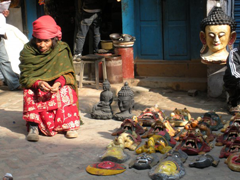
Where was the Buddha born? Careful now. Give the wrong answer and you could find yourself knee-deep in garbage. The upside is, you'll be in wonderful Kathmandu.
People in the Nepalese capital city have been a little pissed lately -- pissed at a movie, and pissed at India. That last part goes with the Nepalese territory. Antipathy for India is expressed in the very minutes of each Nepalese day. Consider: when leaving Singapore for New Delhi, you set your watch back two hours. When leaving Singapore for Kathmandu, you set your watch back two hours... and fifteen minutes. Nepal insists on being chronologically out of step with India. Just the Nepalese way of saying screw you, neighbour.
In January, though, that standard pugnacious attitude exploded into anti-India street demonstrations. The new irritant is a movie, a Hollywood/Bollywood co-production called Chandri Chowk to China. The film suggests that Siddhartha, the Buddha, was born in India. Imagine a Wayne Gretzky biopic, directed by Ron Howard, depicting his happy boyhood on a backyard rink in Salt Lake City, Utah, and you might have some sense of the Nepalese reaction to this movie.
Hellish Nirvana
Then again, you might not. Nepalese people got so upset that the streets of Kathmandu filled up with garbage. Dumpsite towns outside the city refused to accept Kathmandu garbage until the movie was banned. On almost every block stray dogs and wandering cattle graze on open piles of refuse. The film was duly banned, the producer promised to edit out the offending scene, and yet street demonstrations went on regardless.
None of which should dissuade you from visiting. Kathmandu is a magical shithole. This is a city of marvels and fascination, of holy sites and shops full of affordable treasures. But it's no picnic. In Kathmandu, power outages are not a surprise -- they're scheduled daily. The streets are thick with smoke and exhaust and that murderous, merciless traffic for which Asian metropolises are so often famous. Vehicles do everything but crawl over each other to keep moving -- stick your arm out the cab window and you always risk elbowing a motorcyclist. There are neighbourhoods where dirt roads and grazing cattle lend the air of hillside villages. There are roads and alleys that suddenly devolve into something less. Kathmandu is the city where shocks and suspensions go to die, where a cross-town cab journey can make the Dakar Rally seem like a BMW ride down the Autobahn. Meanwhile, a transfixing succession of sights will be crawling past your window -- open fires and candlelit shops, cattle and goats, painted holy men, bicycle rickshaws and water tankers jostling for space, decayed and crumbling structures spilling out into rocky gullies meant to pass for roads. And on black evenings when the streetlights are powerless, passing headlights throw oscillating, smoky shadows all around you and highlight the rutted sidewalks like little Himalayan ranges under your feet. You can't buy that kind of atmosphere, certainly not with a reliable power grid.
The latest goddess
Kathmandu offers dozens of shrines, stupas, and temples where tribute is offered to ancient deities. But you can catch a live one, too. She is the Living Goddess Kumari. She's about four years old and quite new at the goddess trade -- only been on the job four weeks, after replacing the previous goddess. Each new Living Goddess Kumari hangs onto the role until the onset of menstruation. Then they find a new goddess. And the old one? Off to leave a resume at KFC, I guess. If being a child star is tough, imagine being a washed-up goddess at age 12.
The Living Goddess Kumari is selected based on 32 qualities. Some are simple enough -- black hair, even teeth. Others are tougher. The Living Goddess must have a cow's eyes and the heart of a lion. The latter they test by putting little candidates in a dark little room and trying to scare the bejesus out of them. The winning candidate, no crying she makes.
The newly selected Goddess moves into Kumari Ghar, a ramshackle 18th century temple in Darbar Square, the heart of town. She then commences doing what goddesses do -- she appears. There's no telling when. Never between noon and four PM, though. Around 4:30 one day I was hanging around the small temple courtyard with a few Germans and Koreans. Suddenly a man popped his head into an upstairs window and began speaking, apparently instructing us that no photos are allowed and donations should be stuffed into the nearby box. Then bang, there she was, peering over an upper balcony railing -- the Living Goddess Kumari. She wore a shimmery orange gown and a red headpiece. For a four-year-old she seemed to wear a lot of makeup. But her big eyes were indeed cow-like. She looked us over for a bit, then swung off the railing and disappeared.
On to Pashupati
From the living to the dead -- Pashupati is a holy Hindu complex that straddles the fetid yet sacred Bagmati River. Burning pyres and covered corpses mark this as the site where the Hindu faithful must be brought for ritual cremation after being dipped in the river water. Local guides will tell you that the Bagmati eventually becomes the Ganges, where Indian Hindus perform similar rites. But this appears to be another case of Nepali one-upsmanship -- I can't find any evidence that the two are actually connected.
Monkeys scamper everywhere, with Hindu holy men only somewhat less numerous. A little group of gurus is apparently visiting from India, sitting around near naked, faces daubed with ash and paint. One of the visiting gurus seems to be engaged in debate with a local. I ask a bystander what they are discussing. The reply: "He is asking the holy man: 'Where was the Buddha born?'"
And these are just the Hindus.
Related Tyee stories:
- In the Thrall of the Passionate Buddha (photo essay)
He spooks official China; he enraptures Goldie Hawn. How to explain the impact of the Tibetan spiritual leader? Photos by Rob Kruyt - Bashing Heads for Buddha
'The Thai Warrior' fights to get his country back from white pervs and fratheads. - 'The Jesus Sayings'
Author Rex Weyler on sorting myth from history, and why we need both.















Tyee Commenting Guidelines
Comments that violate guidelines risk being deleted, and violations may result in a temporary or permanent user ban. Maintain the spirit of good conversation to stay in the discussion.
*Please note The Tyee is not a forum for spreading misinformation about COVID-19, denying its existence or minimizing its risk to public health.
Do:
Do not: